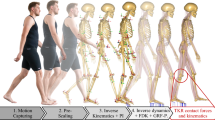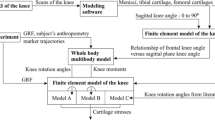Abstract
A better understanding of the time-dependent biomechanical behaviour of the biphasic hip articular cartilage (AC) under physiological loadings is important to understand the onset of joint pathology and guide the clinical treatment. Current computational studies for the biphasic hip AC were usually limited to short-term duration or using elaborate loading. The present study aimed to develop a multiscale computational modelling to investigate the long-term biphasic behaviour of the hip AC under physiological loadings over multiple gait cycles. Two-scale computational modelling including a musculoskeletal model and a finite element model of the natural hip was created. These two models were then combined and used to investigate the biphasic behaviour of hip AC over 80 gait cycles. The results showed that the interstitial fluid pressure in the AC supported over 89% of the loading during gait. When the contact area was located at the AC centre, the contact pressure and fluid pressure increased over time from the first cycle to the 80th cycle, while when the contact area approached the edge, these pressures decreased first dramatically and then slowly over time. The peak stresses and strains in the solid matrix of the AC remained at a low level and increased over time from the first cycle to the 80th cycle. This study demonstrated that the long-term temporal variations of the biphasic behaviour of hip AC under physiological loadings are significant. The methodology has potentially important implications in the biomechanical studies of human cartilage and supporting the development of cartilage substitution.








Similar content being viewed by others
Data availability
All data needed to evaluate the conclusions of this study were presented herein. Additional data related to this study may be requested from the authors.
Code availability
The open-source FE software FEBio used for biomechanical analysis is available on: www.febio.org. The Matlab code for the multiscale approach was made publicly accessible in a GitHub repository (https://github.com/xj-hua/MultiscaleHip).
References
Anderson AE, Ellis BJ, Maas SA, Peters CL, Weiss JA (2008) Validation of finite element predictions of cartilage contact pressure in the human hip joint. J Biomech Eng 130:051008
Anderson AE, Ellis BJ, Maas SA, Weiss JA (2010) Effects of idealized joint geometry on finite element predictions of cartilage contact stresses in the hip. J Biomech 43:1351–1357
Andersen MS, Damsgaard M, MacWilliams B, Rasmussen J (2010) A computationally efficient optimisation-based method for parameter identification of kinematically determinate and over-determinate biomechanical systems. Comput Methods Biomech Biomed Engin 13:171–183
Ateshian GA (2009) The role of interstitial fluid pressurization in articular cartilage lubrication. J Biomech 42:1163–1176
Bader DL, Salter DM, Chowdhury TT (2011) Biomechanical influence of cartilage homeostasis in health and disease. Arthritis 2011:979032
Bergmann G, Bender A, Dymke J, Duda G, Damm P (2016) Standardized loads acting in hip implants. PLoS ONE 11:e0155612
Bergmann G, Deuretzbacher G, Heller M, Graichen F, Rohlmann A, Strauss J, Duda GN (2001) Hip contact forces and gait patterns from routine activities. J Biomech 34:859–871
Byers PD, Contepomi CA, Farkas TA (1970) A post mortem study of the hip joint. Including the prevalence of the features of the right side. Ann Rheum Dis 29:15–31
Caligaris M, Ateshian GA (2008) Effects of sustained interstitial fluid pressurization under migrating contact area, and boundary lubrication by synovial fluid, on cartilage friction. Osteoarthr Cartil 16:1220–1227
Carbone V, Fluit R, Pellikaan P, van der Krogt MM, Janssen D, Damsgaard M, Vigneron L, Feilkas T, Koopman HFJM, Verdonschot N (2015) TLEM 2.0-A comprehensive musculoskeletal geometry dataset for subject-specific modeling of lower extremity. J Biomech 48:734–741
Damsgaard M, Rasmussen J, Christensen ST, Surma E, de Zee M (2006) Analysis of musculoskeletal systems in the AnyBody modeling system. Simul Model Pract Theory 14:1100–1111
Ehlers W, Karajan N, Markert B (2009) An extended biphasic model for charged hydrated tissues with application to the intervertebral disc. Biomech Model Mechanobiol 8(3):233–251
Felson DT (2013) Osteoarthritis as a disease of mechanics. Osteoarthr Cartil 21:10–15
Fischer MCM, Eschweiler J, Schick F, Asseln M, Damm P, Radermacher K (2018) Patient-specific musculoskeletal modeling of the hip joint for preoperative planning of total hip arthroplasty: a validation study based on in vivo measurements. PLoS ONE 13:e0195376
Guilak F (2011) Biomechanical factors in osteoarthritis. Best Pract Res Clin Rheumatol 25:815–823
Harris MD, Anderson AE, Henak CR, Ellis BJ, Peters CL, Weiss JA (2012) Finite element prediction of cartilage contact stresses in normal human hips. J Orthop Res 30:1133–1139
Hayes A (1992) A study of the damage of articular cartilage caused by crystals. Dissertation, University of Bath, Bath.
Henak CR, Ateshian GA, Weiss JA (2014) Finite element prediction of transchondral stress and strain in the human hip. J Biomech Eng 136:021021
Hevesi M, Jacob G, Shimomura K, Ando W, Nakamura N, Krych AJ (2020) Current hip cartilage regeneration/repair modalities: a scoping review of biologics and surgery. Int Orthop 45(2):319–333
Hosseini A, Velde SK, Kozanek M, Gill TJ, Grodzinsky AJ, Rubash HE, Li G (2010) In-vivo time-dependent articular cartilage contact behavior of the tibiofemoral joint. Osteoarthr Cartil 18:909–916
Jones B, Hung CT, Ateshian G (2016) Biphasic analysis of cartilage stresses in the patellofemoral joint. J Knee Surg 29:92–98
Kempson GE (1982) Relationship between the tensile properties of articular cartilage from the human knee and age. Ann Rheum Dis 41:508–511
Lewinnek GE, Lewis JL, Tarr R, Compere CL, Zimmerman JR (1978) Dislocations after total hip-replacement arthroplasties. J Bone Joint Surg Am 60:217–220
Lievense AM, Bierma-Zeinstra SMA, Verhagen AP, Bernsen RMD, Verhaar JAN, Koes BW (2003) Influence of sporting activities on the development of osteoarthritis of the hip: a systematic review. Arthritis Rheum 49(2):228–236
Li J, Hua X, Jin Z, Fisher J, Wilcox RK (2014a) Biphasic investigation of contact mechanics in natural human hips during activities. Proc Inst Mech Eng H 228:556–563
Li J, Hua X, Jones A, Williams S, Jin Z, Fisher J, Wilcox RK (2016) The influence of the representation of collagen fibre organisation on the cartilage contact mechanics of the hip joint. J Biomech 49:1679–1685
Li J, Stewart TD, Jin Z, Wilcox RK, Fisher J (2013) The influence of size, clearance, cartilage properties, thickness and hemiarthroplasty on the contact mechanics of the hip joint with biphasic layers. J Biomech 46:1641–1647
Li J, Wang Q, Jin Z, Williams S, Fisher J, Wilcox RK (2014b) Experimental validation of a new biphasic model of the contact mechanics of the porcine hip. Proc Inst Mech Eng H 228:547–555
Linn FC (1967) Lubrication of animal joints. I. The arthrotripsometer. J Bone Joint Surg Am 49:1079–1098
Liu A, Sanderson WJ, Ingham E, Fisher J, Jennings LM (2020) Development of a specimen-specific in vitro pre-clinical simulation model of the human cadaveric knee with appropriate soft tissue constraints. PLoS ONE 15(10):e0238785
Liu L, Ecker TM, Schumann S, Siebenrock KA, Zheng G (2016) Evaluation of constant thickness cartilage models vs. patient specific cartilage models for an optimized computer-assisted planning of periacetabular osteotomy. PLoS ONE 11:e0146452
Lund ME, Andersen MS, de Zee M, Rasmussen J (2015) Scaling of musculoskeletal models from static and dynamic trials. Int Biomech 2:1–11
Mabuma J, Schwarze M, Hurschler C, Markert B, Ehlers W (2015) Effects of osteoarthritis and pathological walking on contact stresses in femoral cartilage. Biomech Model Mechanobiol 14(6):1167–1180
Macirowski T, Tepic S, Mann RW (1994) Cartilage stresses in the human hip joint. J Biomech Eng 116:10–18
McCann L, Ingham E, Jin Z, Fisher J (2009) Influence of the meniscus on friction and degradation of cartilage in the natural knee joint. Osteoarthr Cartil 17:995–1000
Modenese L, Phillips ATM (2012) Prediction of hip contact forces and muscle activations during walking at different speeds. Multibody Syst Dyn 28:157–168
Mow VC, Kuei SC, Lai WM, Armstrong CG (1980) Biphasic creep and stress relaxation of articular cartilage in compression? Theory and experiments. J Biomech Eng 102:73–84
Nakano N, Gohal C, Duong A, Ayeni OR, Khanduja V (2018) Outcomes of cartilage repair techniques for chondral injury in the hip-a systematic review. Int Orthop 42:2309–2322
Pawaskar SS, Ingham E, Fisher J, Jin Z (2011) Fluid load support and contact mechanics of hemiarthroplasty in the natural hip joint. Med Eng Phys 33:96–105
Pieri ED, Lund ME, Gopalakrishnan A, Rasmussen KP, Lunn DE, Ferguson SF (2018) Refining muscle geometry and wrapping in the TLEM 2 model for improved hip contact force prediction. PLoS ONE 13:e0204109
Quiroga JM, Wilson W, Ito K, van Donkelaar CC (2017) Relative contribution of articular cartilage’s constitutive components to load support depending on strain rate. Biomech Model Mechanobiol 16:151–158
Recnik G, Kralj-Iglic V, Iglic A, Antolic V, Kramberger S, Rigler I, Pompe B, Vengust R (2009) The role of obesity, biomechanical constitution of the pelvis and contact joint stress in progression of hip osteoarthritis. Osteoarthr Cartil 17:879–882
Segal NA, Anderson DD, Iyer KS, Baker J, Torner JC, Lynch JA, Felson DT, Lewis CE, Brown TD (2009) Baseline articular contact stress levels predict incident symptomatic knee osteoarthritis development in the MOST cohort. J Orthop Res 27:1562–1568
Shepherd DE, Seedhom BB (1999) Thickness of human articular cartilage in joints of the lower limb. Ann Rheum Dis 58:27–34
Todd JN, Allan AN, Maak TG, Weiss JA (2021) Characterization and finite element validation of transchondral strain in the human hip during static and dynamic loading. J Biomech 114:110143
Todd JN, Maak TG, Ateshian GA, Maas SA, Weiss JA (2018) Hip chondrolabral mechanics during activities of daily living: role of the labrum and interstitial fluid pressurization. J Biomech 69:113–120
Wilson W, van Donkelaar CC, van Rietbergen R, Huiskes R (2005) The role of computational models in the search for the mechanical behavior and damage mechanisms of articular cartilage. Med Eng Phys 2005:810–826
Yoshida H, Faust A, Wilckens J, Kitagawa M, Fetto J, Chao EY-S (2006) Three-dimensional dynamic hip contact area and pressure distribution during activities of daily living. J Biomech 39:1996–2004
Funding
This project has received funding from the EU Horizon 2020 research and innovation programme under the Marie Sklodowska-Curie Grant Agreement No. 745426.
Author information
Authors and Affiliations
Contributions
The authors all contributed to the writing and planning of the manuscript.
Corresponding authors
Ethics declarations
Conflict of interest
The authors declare that they have no conflict of interest.
Additional information
Publisher's Note
Springer Nature remains neutral with regard to jurisdictional claims in published maps and institutional affiliations.
Rights and permissions
About this article
Cite this article
Hua, X., Shu, L. & Li, J. Multiscale modelling for investigating the long-term time-dependent biphasic behaviour of the articular cartilage in the natural hip joint. Biomech Model Mechanobiol 21, 1145–1155 (2022). https://doi.org/10.1007/s10237-022-01581-6
Received:
Accepted:
Published:
Issue Date:
DOI: https://doi.org/10.1007/s10237-022-01581-6




